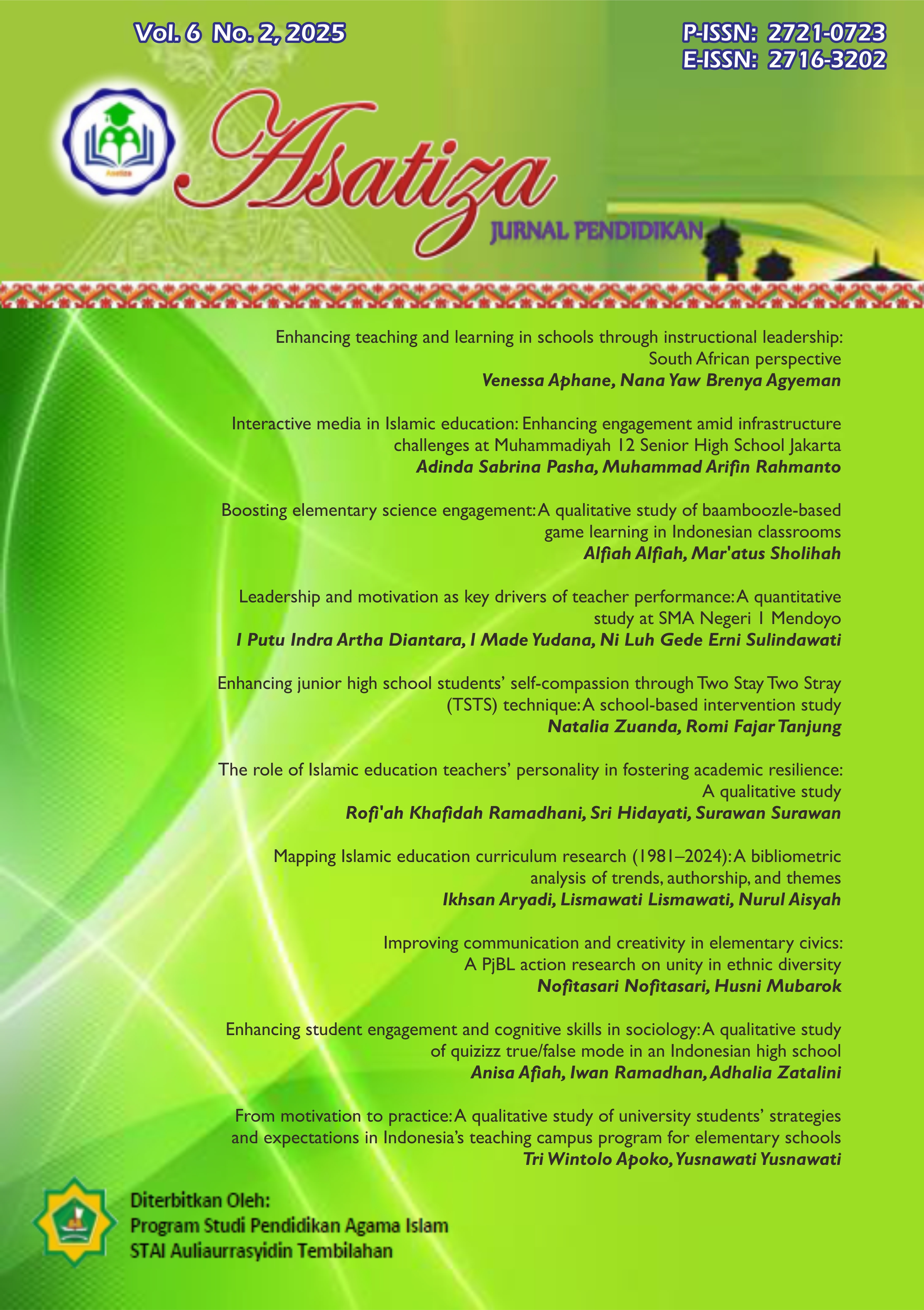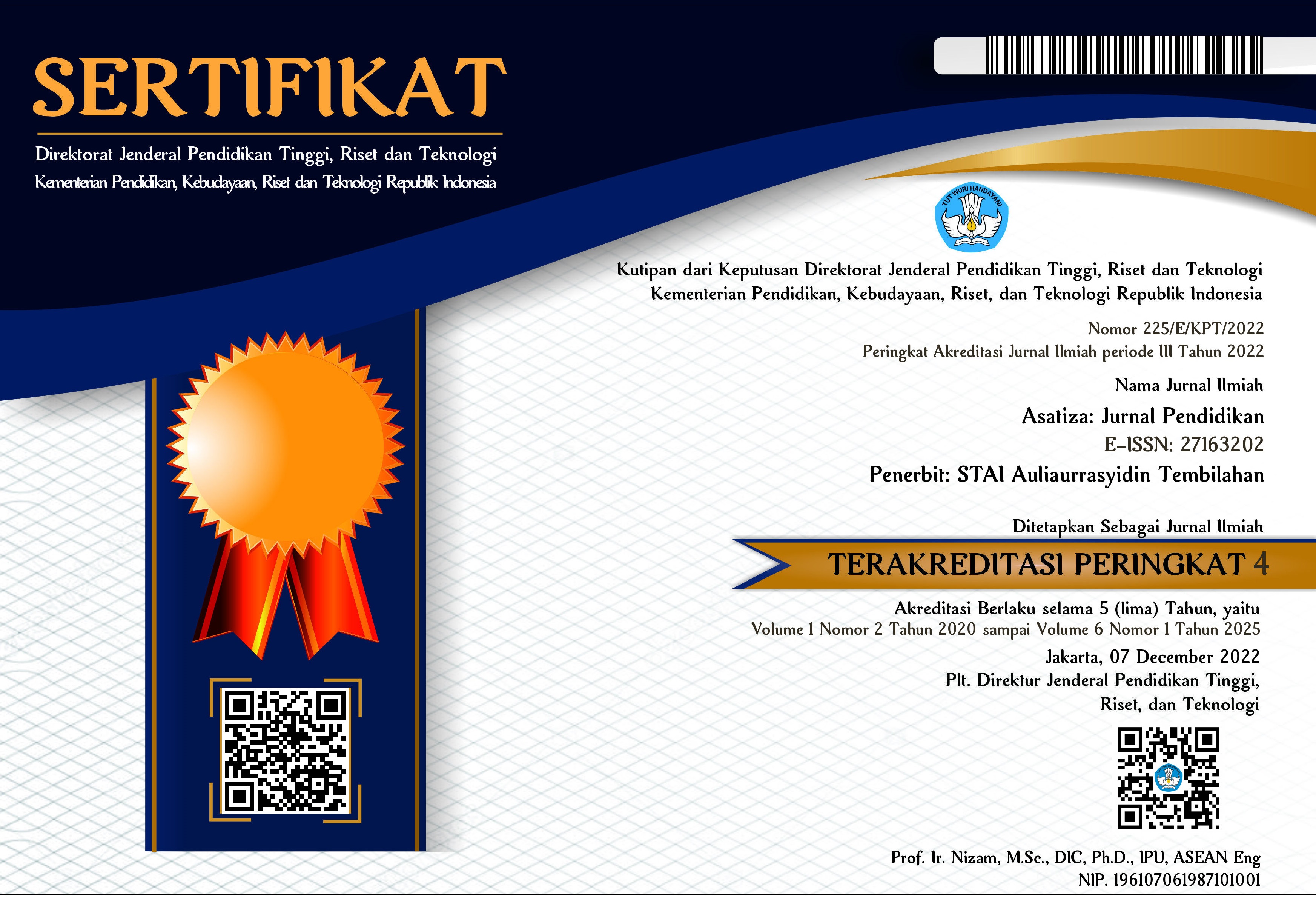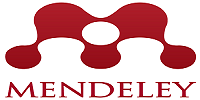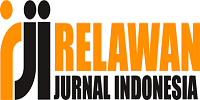Enhancing student engagement and cognitive skills in sociology: A qualitative study of quizizz true/false mode in an Indonesian high school
DOI:
https://doi.org/10.46963/asatiza.v6i2.2422Keywords:
Student Engagement, Gamification, Quizizz, Sociology Education, Active LearningAbstract
This study examines a student engagement model utilizing the Quizizz True or False mode in Sociology for Class XI IPS 3. Employing a qualitative descriptive approach, primary data were collected through observations and interviews with the Sociology teacher and 10 purposively selected students representing diverse engagement levels and group dynamics. Secondary data included school documents. Data analysis followed stages of collection, reduction, presentation, and conclusion drawing, with validity ensured through prolonged observation, persistence, and triangulation. Findings reveal that engagement implications encompass four behavioral aspects: (1) participation/contribution, (2) collaboration, (3) initiative/independence, and (4) motivation/interest, all enhancing active learning. Cognitive improvements were observed across four domains: knowledge/comprehension, application, analysis, and evaluation. The model demonstrated efficacy, with average scores rising from 86.67 (first session) to 95 (second session), indicating improved learning outcomes. These results underscore the potential of gamified quiz tools to bolster both engagement and academic performance in social science education.
Downloads
References
Adhi, G. (2020). Active Learning. Tripven. https://www.tripven.com/active-learning/
Ali, S. H. G. (2013). Prinsip-prinsip pembelajaran dan implikasinya terhadap pendidik dan peserta didik. Jurnal Al-Ta’dib, 6(1), 31–42. https://doi.org/10.31332/atdb.v6i1.288
Altinyelken, H. K., & Hoeksma, M. (2021). Improving educational quality through active learning: Perspectives from secondary school teachers in Malawi. Research in Comparative and International Education, 16(2), 117–139. https://doi.org/10.1177/1745499921992904
Anderson, L. W., & Krathwohl, D. R. (2001). A taxonomy for learning, teaching, and assessing: A revision of Bloom’s taxonomy. Longman.
Astari, Z. (2023). Aplikasi quizizz sebagai media pembelajaran untuk meningkatkan motivasi belajar siswa. Jurnal Sosiologi Pendidikan dan Pendidikan IPS (SOSPENDIS), 1(2), 59–65. https://sospendis.adisampublisher.org/index.php/1/article/view/13
Ausubel, D. P. (1968). Educational psychology: A cognitive view. Holt, Rinehart & Winston.
Bahri, S. (2021). Meningkatkan kemampuan guru dalam implementasi model pembelajaran aktif tipe index card match melalui pelatihan e-learning. Action Research Journal Indonesia, 3(1), 19–32. https://doi.org/10.61227/arji.v3i1.29
Bowen, G. A. (2009). Document analysis as qualitative research method. Qualitative Research Journal, 9(2), 27-40. https://doi.org/10.3316/QRJ0902027
Boyd, R., & Silk, J. B. (2017). How humans evolved (8th ed.). Norton.
Creswell, J. W. (2014). Research design: Qualitative, quantitative and mixed methods approaches (4th ed.). Sage.
Creswell, J. W., & Poth, C. N. (2018). Qualitative inquiry and research design (4th ed.). Sage.
Dewi, N. N., & Astuti, I. W. (2021). EFL Students’ perspective on the use of quizizz as online learning media during covid-19 pandemic. Studies in Learning and Teaching, 2(2), 59-68. https://doi.org/10.46627/silet.v2i2.76
Fadhila. A. (2016). Peranan strategi pembelajaran aktif tipe tim quiz (Quiz Team) terhadap kemampuan berpikir kritis siswa pada pembelajaran fisika kelas xi IPA MAN Pol-Man Kabupaten Polewari Mandar. Jurnal Saintifik, 2(2), 105–114. http://dx.doi.org/10.31605/saintifik.v2i2.102
Fauziah, U., Hairida, H., & Melati, H. A. (2014). Peningkatan altivitas dan hasil belajar siswa melalui strategi true or false berbantuan media flash. Jurnal Pendidikan dan Pembelajaran Untan, 3(7), 1–12. https://doi.org/10.26418/jppk.v3i7.6409
Folse, B., & Poole, F. J. (2024). Gamifying Gamification in the Sociology Classroom. Teaching Sociology, 52(3), 206-218. https://doi.org/10.1177/0092055X231175176
Freeman, S., Eddy, S. L., McDonough, M., Smith, M. K., Okoroafor, N., Jordt, H., & Wenderoth, M. P. (2014). Active learning increases student performance in science, engineering, and mathematics. PNAS, 111(23), 8410–8415. https://doi.org/10.1073/pnas.1319030111
Freeman, S., McDonough, S. L. E., Wenderoth, M. P. (2014). Active learning increases student performance in science, engineering, and mathematics. Proceedings of the National Academy of Sciences, 111(23), 8410–8415. https://doi.org/10.1073/pnas.1319030111
Giddens, A. (1984) The Constitution of Society. Outline of the Theory of Structuration. University of California Press, Berkeley.
Hamari, J., Koivisto, J., & Sarsa, H. (2014). Does gamification work? A literature review of empirical studies on gamification. 47th Hawaii International Conference on System Sciences. Waikoloa, HI, USA, 2014, 3025-3034. https://doi.org/10.1109/HICSS.2014.377
Hattie, J. (2009). Visible learning: A Synthesis of Over 800 Meta-Analyses Relating to Achievement. Routledge.
Hattie, J. (2017). Visible Learning: 250+ Influences on Student Achievement. Routledge.
Indriani T., Suyatna A., & Ertikano C. (2015). Pengembangan Kuis Interaktif Tipe True/false Untuk Melatih Kemampuan Eksplorasi Fenomena Fisika. Jurnal Pembelajaran Fisika, 3(1), 131–140. http://jurnal.fkip.unila.ac.id/index.php/JPF/article/view/8128
Jannah, M., Amran, E. Y., Rasmiwetti, R. (2015). Penerapan strategi pembelajaran aktif tipe benar salah berantai (True false chain) untuk meningkatkan prestasi belajar siswa pada pokok bahasan kelarutan dan hasil kali kelarutan di kelas xi IPA MAN 1 Pekanbaru. Jurnal Online Mahasiswa Fakultas Keguruan dan Ilmu Pendidikan Universitas Riau, 2(1), 1–9. https://jom.unri.ac.id/index.php/JOMFKIP/article/view/5925
Johnson, D. W., Johnson, R. T., & Smith, K. A. (2014). Cooperative learning: Improving university instruction by basing practice on validated theory. Journal on Excellence in College Teaching, 25(3/4), 85–118. https://celt.miamioh.edu/index.php/JECT/article/view/454
Krath, J., Schürmann, L., & Von Korflesch, H. F. (2021). Revealing the theoretical basis of gamification: A systematic review and analysis of theory in research on gamification, serious games and game-based learning. Computers in human behavior, 125, 106963. https://doi.org/10.1016/j.chb.2021.106963
Lave, J., & Wenger, E. (1991) Situated Learning: Legitimate Peripheral Participation. Cambridge: Cambridge University Press. http://dx.doi.org/10.1017/CBO9780511815355
Meizar A., Gunawan H., Sianturi N. E., Syahputra, A., & Saputra M. (2021). Pelatihan Aplikasi Quizizz Sebagai Saran Ujian Berbasis Dalam Jaringan. Jurnal Pustaka Mitra (Pusat Akses Kajian Mengabdi Terhadap Masyarakat), 1(1), 54–59. https://jurnal.pustakagalerimandiri.co.id/index.php/pustakamitra/article/view/14
Miao, F., & Holmes, W. (2021). Beyond disruption: technology enabled learning futures; 2020 edition of Mobile Learning Week, 12-14 October 2020: report. https://discovery.ucl.ac.uk/id/eprint/10139698
Milawati, M., & Sholeh, M. (2020, February). Teacher’s readiness in using digital technology for learning in Samarinda city high school. In 2nd International Conference on Social Science and Character Educations (ICoSSCE 2019) (pp. 321-324). Atlantis Press. https://doi.org/10.2991/assehr.k.200130.064
Muis, A. A. (2013). Prinsip-prinsip belajar dan pembelajaran. Istiqra’, 1(1), 29–38. https://jurnal.umpar.ac.id/index.php/istiqra/article/view/199
Muliawan, J. U. (2016). 45 Model Pembelajaran Spektakuler. Yogyakarta: Ar-Ruzz
Nursela, N., Oktaviana, D., & Hodiyanto, H. (2021). Pengembangan buku ajar elektronik interaktif berbantuan google slide dan quizizz terhadap kemampuan pemecahan masalah. Jurnal Nalar Pendidikan, 9(2), 139–147. https://doi.org/10.26858/jnp.v9i1.25384
Prince, M. (2004). Does active learning work? A review of the research. Journal of Engineering Education, 93(3), 223–231. https://doi.org/10.1002/j.2168-9830.2004.tb00809.x
Qorimah, E. N., & Sutama, S. (2022). Studi literatur: Media augmented reality (AR) terhadap hasil belajar kognitif. Jurnal Basicedu, 6(2), 2055–2060. https://doi.org/10.31004/basicedu.v6i2.2348
Raehang, R. (2014). Pembelajaran aktif sebagai induk pembelajaran koomperatif. Jurnal Al-Ta’dib, 7(1), 149–167. https://doi.org/10.31332/atdb.v7i1.249
Rahim, R., & Rahman, M. A. (2022). Pengembangan media pembelajaran berbasis aplikasi quizizz untuk meningkatkan kemampuan pemecahan masalah matematik siswa pada masa pandemi covid-19. Jurnal Ilmiah Universitas Batanghari Jambi (JIUBJ), 22(1), 232–238. https://doi.org/10.33087/jiubj.v22i1.1845
Ramadhan, I. (2024). Pelaksanaan pembelajaran sosiologi model active learning berbasis aplikasi quizizz mode true or false di SMA swasta Mujahidin Pontianak. Didaktika: Jurnal Kependidikan, 13(1), 847-856. https://doi.org/10.58230/27454312.390
Rosyidi, D. (2020). Teknik dan instrumen asesmen ranah kognitif. Jurnal Tarbiyah-Syari’ah Islamiyah, 27(1), 1-13. https://ejournal.kopertais4.or.id/pantura/index.php/tasyri/article/view/3479
Runciman, W. G. (1966). Relative Deprivation and Social Justice. Routledge, London
Rustini, T. (2022). Model interaktif dalam pembelajaran IPS. EduHumaniora: Jurnal Pendidikan Dasar, 4(1), 1–17. https://doi.org/10.17509/eh.v4i1.2818
Ryan, R. M., & Deci, E. L. (2000). Self-determination theory and the facilitation of intrinsic motivation. American Psychologist, 55(1), 68–78. https://doi.org/10.1037/0003-066X.55.1.68
Schindler, L. A., Burkholder, G. J., Morad, O. A., & Marsh, C. (2017). Computer-based technology and student engagement: a critical review of the literature. International journal of educational technology in higher education, 14, 1-28. https://doi.org/10.1186/s41239-017-0063-0
Setyawati. D. A. (2015). Peningkatan keaktifan siswa dan prestasi belajar matematika dengan model pembelajaran tipe TAI (Team Assisted Individualization) pada kelas ix-a semester ganjil SMP Negeri 4 Madiun tahun 2015/2016. Jurnal Edukasi Matematika dan Sains, 4(2), 115–120. http://e-journal.ikippgrimadiun.ac.id/index.php/JEMS
Sumarlina, D., Miharty, M., & Holiwarni, B. (2014). Penerapan strategi pembelajaran aktif tipe true false chain untuk meningkatkan hasil belajar siswa pada pokok bahasan reaksi redoks kelas x SMA Negeri 4 Pekanbaru. Jurnal Online Mahasiswa Fakultas Keguruan Dan Ilmu Pendidikan Universitas Riau, 1(1), 1–6. https://jom.unri.ac.id/index.php/JOMFKIP/article/view/1896
Tati, T., Suhartono, S., & Najah, T. S. (2015). Penerapan strategi pembelajaran aktif tipe the learning cell pada pokok bahasan bunyi. Edu Sains: Jurnal Pendidikan Sains Dan Matematika, 3(1), 26–36. https://doi.org/10.23971/eds.v3i1.252
Taufik, R., Hustim, R., & Nurlina, N. (2014). Penerapan pembelajaran partisipatif metode true-false dalam pembelajaran fisika pada siswa kelas vii b SMP Negeri 17 Bulukumba. Jurnal Pendidikan Fisika Unismuh, 2(3), 245–260. https://doi.org/10.26618/jpf.v2i3.240
Utami, R. P. (2019). Active learning untuk mewujudkan pembelajaran efektif. Jurnal Al-Bidayah, 1(2), 151–166. https://doi.org/10.14421/al-bidayah.v1i2.46
Vygotsky, L. S. (1978). Mind In Society: the Development of Higher Psychological Processes. Harvard University Press.
Wright, M. C., Bergom, I., & Bartholomew, T. (2019). Decreased class size, increased active learning? Intended and enacted teaching strategies in smaller classes. Active learning in higher education, 20(1), 51-62. https://doi.org/10.1177/1469787417735607
Zainuddin, Z., Shujahat, M., Haruna, H., & Chu, S. K. W. (2020). The role of gamified e-quizzes on student learning and engagement: An interactive gamification solution for a formative assessment system. Computers & education, 145, 103729. https://doi.org/10.1016/j.compedu.2019.103729
Zimmerman, B. J. (2002). Becoming a Self-Regulated Learner: An Overview. Theory Into Practice, 41(2), 64–70. https://doi.org/10.1207/s15430421tip4102_2
Downloads
Published
Issue
Section
License
Copyright (c) 2025 Anisa Afiah, Iwan Ramadhan, Adhalia Zatalini

This work is licensed under a Creative Commons Attribution-ShareAlike 4.0 International License.
Authors who publish with this journal agree to the following terms:
1. Copyright on any article is retained by the author(s).
2. The author grants the journal, right of first publication with the work simultaneously licensed under a Creative Commons Attribution shareAlike 4.0 International License that allows others to share the work with an acknowledgment of the work’s authorship and initial publication in this journal.
3. Authors are able to enter into separate, additional contractual arrangements for the non-exclusive distribution of the journal’s published version of the work (e.g., post it to an institutional repository or publish it in a book), with an acknowledgment of its initial publication in this journal.
4. Authors are permitted and encouraged to post their work online (e.g., in institutional repositories or on their website) prior to and during the submission process, as it can lead to productive exchanges, as well as earlier and greater citation of published work.
5. The article and any associated published material is distributed under the Creative Commons Attribution-ShareAlike 4.0 International License











2.png)



